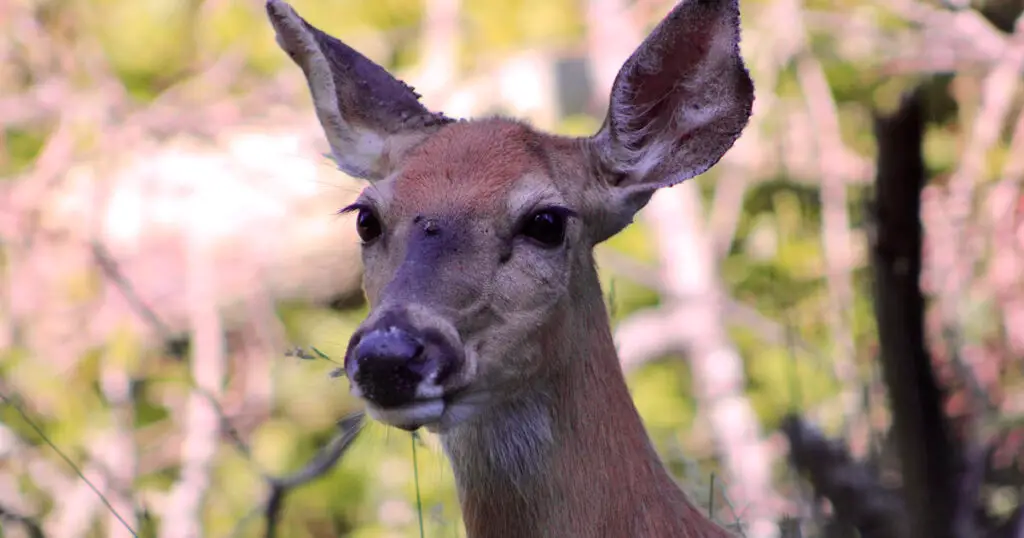Like other mammals in the wild, whitetail deer are ideal hosts for parasites and the diseases they may cause. Deer can contract these parasites from other deer and their environment. Deer can tolerate most of these parasitic hitchhikers, but certain parasites can cause illness. Let’s find out more in this complete guide to deer parasites.
These are parasites and diseases you should know about this hunting season, including what they are, their symptoms in deer, and what you should do if you ever encounter an ill deer.
What Is a Parasite?
To start this guide off, we will take a moment to discuss exactly what a parasite is and how it can affect a host (the deer).
A parasite, otherwise described as a dependent organism, is an invertebrate that relies on a host to survive. Using that organism to feed and reproduce, more often than not, negatively affects its host.
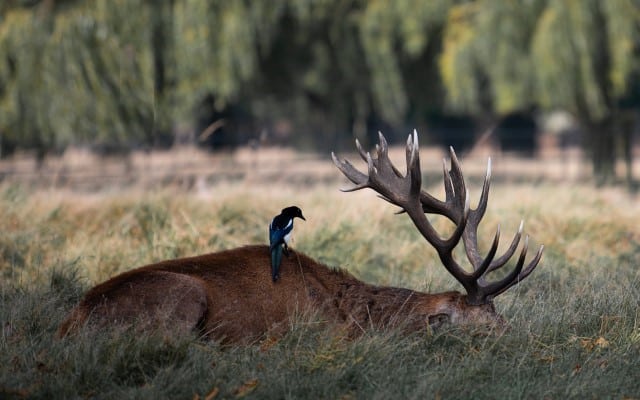
Parasites can be bacteria, viruses, protists, fungi, plants, or in some cases, animals. It has been estimated that around 40% of animal species are parasitic.
Generally, parasites share the following features:
- Many parasites have claws, hooks, or suckers to attach to their host.
- Parasites typically don’t kill their host but can harm them indirectly by spreading pathogens.
- This may affect the animal’s reproductive activity, eating habits, and behavior
- Parasites are usually much smaller than their host
- They can feed on both invertebrates and vertebrate hosts.
Recognizing a Sick Deer
Experts define disease or illness as an abnormal condition of the body or mind that interferes with an animal’s functioning. We can usually recognize deer disease by key signs and symptoms, such as abnormal behavior and appearance.
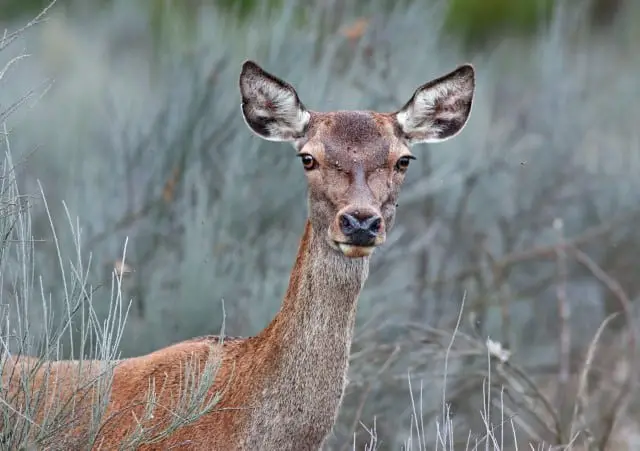
Luckily, wild deer tend to be remarkably free of disease. It’s relatively easy to spot one that is ill or out of sorts.
If you come across a deer displaying any of these symptoms or one deceased from what looks to be unnatural causes, contact your nearest state or federal wildlife department. They will investigate the happening and relay it to the town’s local health department.
Indicators of Illness
Here are some common indicators of illness in deer.
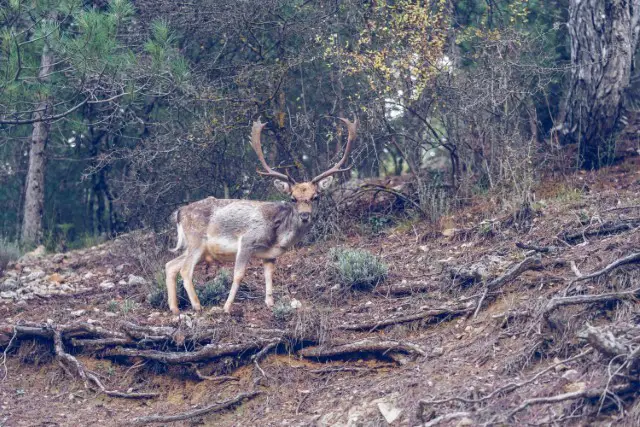
Angular Body Condition in the Back
Body condition around the lower back and rump area is more angular, revealing the shape of the animal’s spine and concave ribs to be fairly visible. Loin would also have little to no fat covering in this case.
Diarrhea or Stiff Feces
Diarrhea or stiff feces coating the animal’s back end may also be a sign of disease
Drooling or Foaming at the Mouth
Excessive drooling or foaming from the mouth or nose
Lameness
A deer may have trouble standing or lose its balance.
Confusion
The deer may walk in circles or shake its head almost as if being in a confused haze.
Paralysis or Collapsing
You may see a deer collapsing before trying to start again. There may even be apparent paralysis.
Deformed Antlers or Unusual Shedding
Deformed antlers or antler shedding at unusual times are potential signs of disease.
Aggression Outside the Mating Season
Deer aggression can be a sign of illness. If a male deer charges at you or is aggressive and it isn’t the mating season, it could be ill.
What Parasites Can Deer Carry?
There are both internal and external common parasites in deer. Internal parasites live within the intestinal tract and respiratory system. External parasites, on the other kind, live in the skin and/or fur.
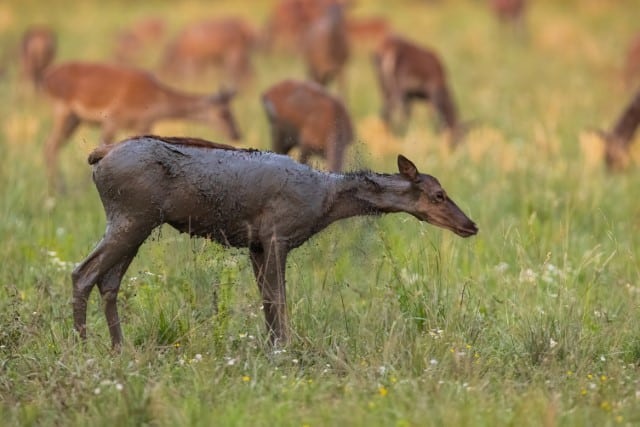
Internal Parasites
Here are two internal parasites deer sometimes have.
Liver Fluke
Liver flukes are parasitic flatworms that look like a leech swimming around the liver, each fluke measuring around 1 to 5 inches in length.
This parasite is also similar in color to the actual liver itself, making them quite challenging to spot.
In some extreme cases, a doe or buck contracted with liver fluke can die as carrying this parasite can result in liver failure.
Symptoms
A liver fluke infection can cause diarrhea, lethargy, loss of appetite, weight loss, and death. Deer with liver fluke parasites may have a swollen, hemorrhagic liver.
Treatment
Wildlife specialists sometimes give a medicated feed called Triclabendazole, a corn-based feed, to white-tailed deer. This results in lower liver fluke cases in deer.
Sarcocystis
This parasite has a two-stage life cycle, which in this case means it requires two separate hosts before its cycle ends: an intermediate host (usually an herbivorous species) and a definitive host (usually a predator or carnivorous animal).
The cycle begins with the intermediate host ingesting infectious sporocysts.
Deer contract these protozoa accidentally during their regular grazing or drinking, where the parasite then migrates to the animal’s muscles and begins developing a pocket like a cyst.
They look similar to that of a grain of rice. Predators are a part of the Sarcocystis cycle.
When predators eat deers with this parasite, it continues its life cycle. When the parasite matures, the predator passes it back to the environment.
Deer can then pick up Sarcocystis again.
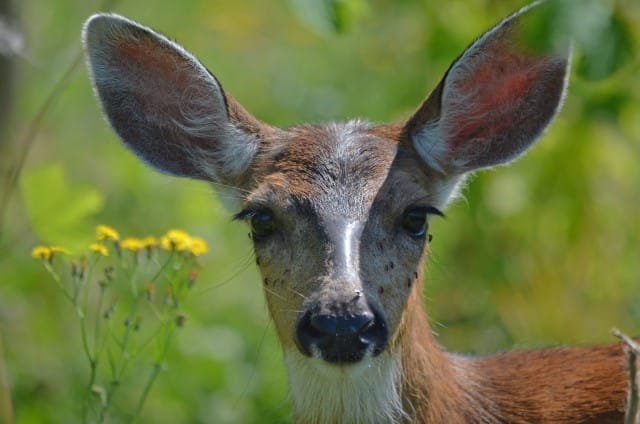
Symptoms
With this pathogen, recognizable symptoms are hard to come by in most living animals.
Signs of disease are usually visible before we can diagnose Sarcocystis. A deer can be either visibly lame or have bouts of paralysis when there is a severe infection.
Treatment
There are currently no solid treatment plans for Sarcocystis in wildlife. However, physicians have used Albendazole to treat this disease in humans.
External Parasites
Here are some common external parasites that affect deer.
Lice
Three types of lice can affect deer.
One has a hook mouth for sucking blood (Solenopotes binipilosus).
The other two are chewing lice (Tricholipeurus lipeuroides and T. parallenus). These lice types feed on the animal’s skin rather than its blood.
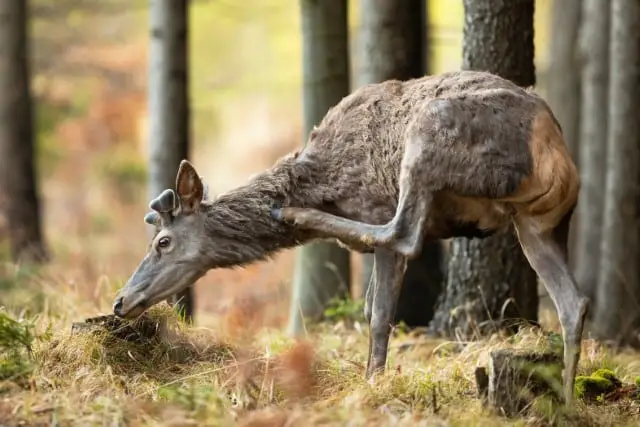
Deer catch lice from each other when they come into direct contact. Spending their life cycle near the surface, they attach closely to the hair of the deer to stay on.
Louse populations fluctuate between seasons as infestations tend to happen during late winter and early spring.
Symptoms
Most deer affected by lice have no clinical symptoms, but those that do can either look like they’ve been through a stage of balding or look moth-eaten. They will also show signs of irritated skin by itching, which could cause a lot of self-trauma to the point where the skin and fur appear to be in rough condition.
Treatment
Currently, there is no simple method of delivering the effective doses of medication needed to remove lice from these animals’ skin. Many resolve their infestation, and their hair will return to usually come summertime when their immune system is back to normal.
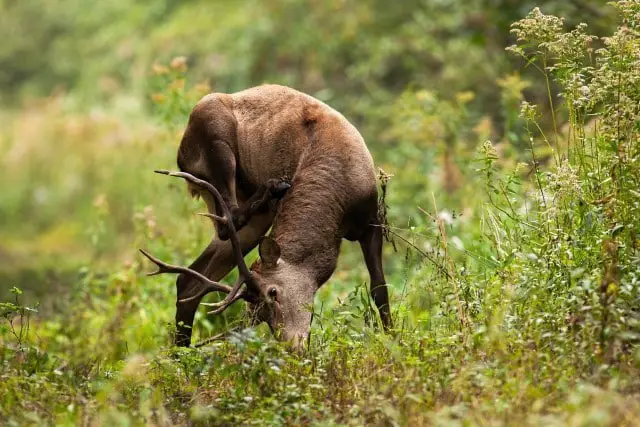
Deer Ked
The deer ked is also known as the deer fly. It’s an ectoparasite that is fast-moving when it has been disturbed.
The deer fly will bite humans if they have the chance, but they’re not as harmful as ticks. However, they do carry Lyme disease.
Symptoms
Like a regular bug bite, if a ked feeds on its host, the deer’s skin will begin to welt and feel itchy where it’s been bitten.
Treatment
There is no treatment method actively being in use due to the fact that deer ked is mainly controlled within the deer population and is primarily seen during the summer months as they don’t travel much during the winter season.
Generally, they live for about six months on their host.
Parasitic Worms
While worms are another form of internal parasite, we’ll separate them as they have some unique characteristics.
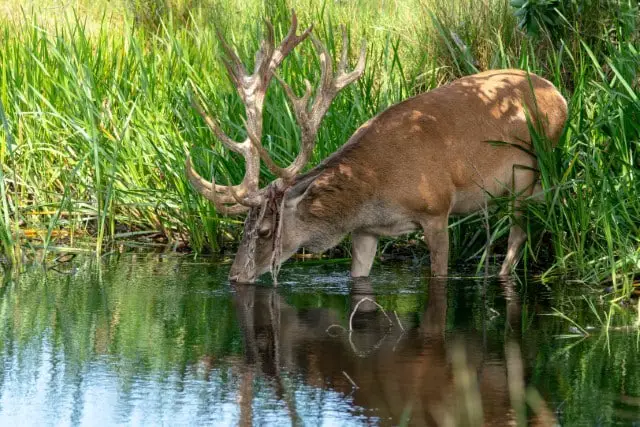
Meningeal Worm
This worm tends to live in the meninge, the tissue layer surrounding the brain and spinal cord. These worms can cause neurological damage and behavioral issues if there is a heavy infestation.
Like the liver fluke, meningeal worms begin their life cycle after being ingested. Deer contract this type of pathogen if they eat an infected snail or slug when grazing.
Arterial Worm
Otherwise known as lumpy jaws, this parasite causes large masses to form on the side of the infected deer’s face. If you get a closer look, you might notice its texture is similar to chewing tobacco.
This is because adult worms live in the carotid artery of the animal’s neck.
When enough worms are together, they can pressurize the vein and cause a lack of blood flow to the jaw muscle, interfering with the deer’s ability to chew or drink.
This causes food to build up under the tongue and become impacted in the cheek, leading to emaciation and other forms of infections.
This parasite travels by horsefly. Horseflies pick up the larva. These flies bite and feed on an infected deer’s blood before they grow and migrate to their next victim in adulthood.
Nasal Bots
Nasal bots are maggots or larvae of the cephenemyia fly found in the nasal cavities of deer. Once laid, they grow in large numbers.
When this happens, they can irritate the lining of the affected deer’s nasal passage as they move about.
In some cases, you may see a deer constantly sneezing or coughing due to the irritation.
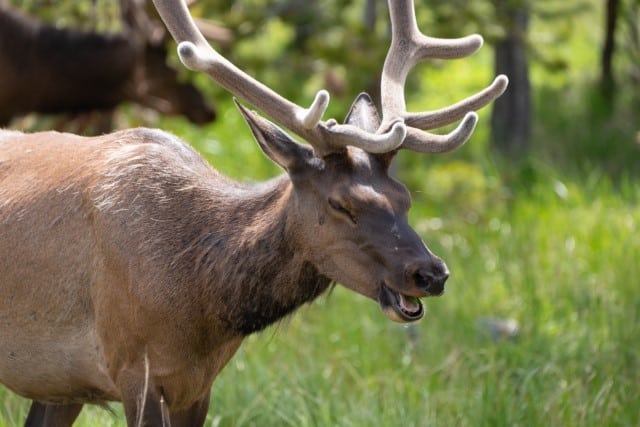
Lungworm
If you’ve ever killed a deer and began cutting along its windpipe or the passage of where the animal’s lungs sit, there’s a chance you’ll find long, spaghetti-like worms that are still moving around.
These are adult lungworm. The larvae from the original first eaten parasite go through a cycle of crawling up the windpipe before becoming swallowed and passing through the animal’s stool to the forest floor only in hopes of being picked up by another host.
A deer carrying too many lungworm at once can develop pneumonia, making it hard for the deer to breathe.
Rare Parasites and Diseases in Deer
Now you know the most common deer parasites, let’s take a look at some rare ones. These include:
- Tularemia
- Epizootic Hemorrhagic Disease
- Chronic Wasting Disease
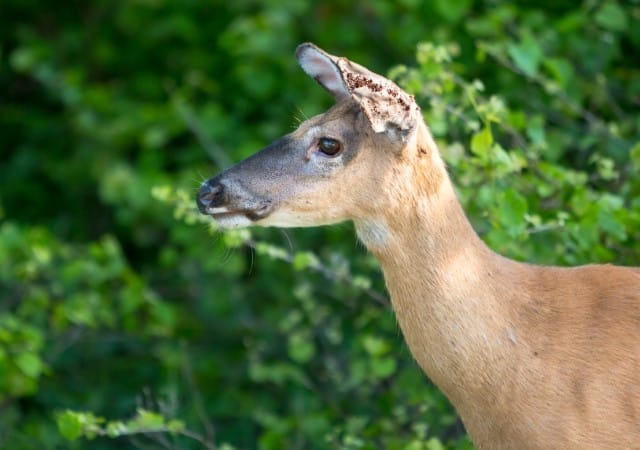
Tularemia
This rare disease is caused by the bacterium Francisella tularensis. Many wild animals are reservoirs for the bacteria to grow before being transmitted to humans through either a tick bite, deerfly, or contact with an infected carcass.
Symptoms include chest pains, coughing, and difficulty breathing.
Epizootic Hemorrhagic Disease
EDH is an infectious virus that is fatal to white-tailed deer that contract it. It is contractible by a gnat that picks up the virus from the host and then plants in another host while feeding. The virus often causes internal bleeding.
It’s generally a term for an illness caused by two related viruses and can decimate an entire herd in a span of 10 days.
Clinical signs begin to appear after the virus’s incubation period of approximately 7-10 days after infection. The animal’s health will start to decline and symptoms may include a reduced appetite, fever, swollen head or neck, weakness, and then a swift death within the span of 24hrs.
Chronic Wasting Disease
CWD is a fatal disease found in some deer species that can take a toll on the herd population when a breakout occurs.
Chronic Wasting Disease damages a large portion of the animal’s brain and can typically cause progressive weight loss, extreme salivation, seizures, dehydration, and behavioral changes before death sets in.
Rivers and shorelines find most of the diseased deer that were once infected due to their severe dehydration.
There is no cure for this disease that is spread between animals by direct contact.
What Time of Year Are Deer Parasites the Worst?
In many cases, deer have a higher chance of contracting a parasite during early spring and late summer.
That is the time when the snow is melting, allowing spores to be released from the ground and parasites to become more active.
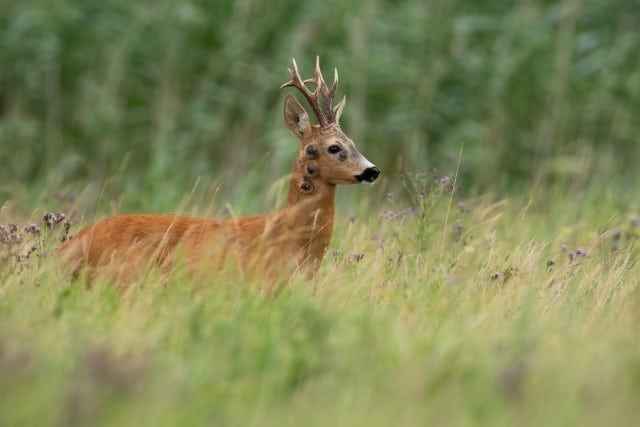
Can Humans Catch Deer Parasites?
Yes, humans can catch deer parasites in some cases.
This is just one reason you must be careful and use hygienic practices when handling wildlife.
Here is a list of steps you can take to protect yourself from catching deer parasites:
Thoroughly Cook the Venison
Venison always needs thorough cooking.
Don’t try to eat rare venison. It isn’t safe.
Wear Gloves
Always wear gloves when handling a deer carcass. Be meticulous with your field dressing practices.
Freeze the Meat
Freezing the meat will help kill off any significant parasites before cooking. It will also keep it fresh for longer periods.
Wash Your Hands
Thoroughly wash your hands both before and after handling the animal.
What is a Zoonotic Disease?
A zoonotic disease is a pathogen that a sick or infected animal can transfer to humans under natural conditions.
Typically, deer are mostly infected with diseases that won’t transfer to humans. However, there are quite a few cases of zoonotic parasites that deer may carry.
Here are some examples of zoonotic diseases that humans may catch from deer:
Toxoplasmosis
In rare case reports, deer have transmitted toxoplasma to people who consumed the infected venison, which was uncooked or raw.
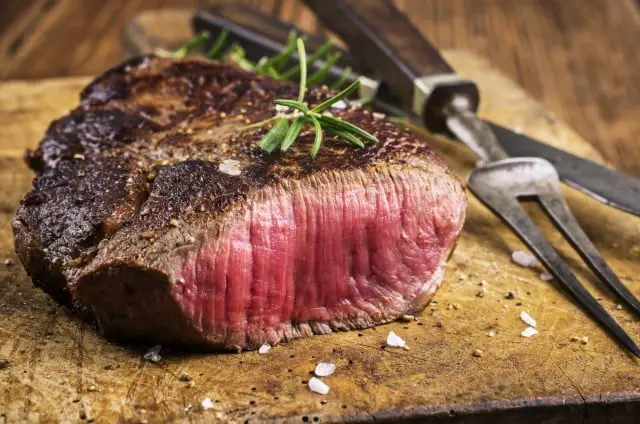
The toxoplasmosis gondii parasite causes this disease. It can cause swollen lymph nodes, headaches, seizures, and more.
Leptospirosis
This is a bacterial disease that affects both animals and humans. Caused by the genus Leptospira, it can cause an extensive range of symptoms that many might confuse for signs of other illnesses, including high fever, headaches, chills, vomiting, etc.
Deer usually pick the bacteria by grazing infected pasture or drinking water contaminated with an infected animal’s urine or fecal matter.
Dermatophilosis
The white-tailed deer is one of the many mammals known to be affected by this bacterial skin infection.
This spore-forming bacterium is thought to originate from the soil but has not yet been proven from that single environment.
Other Diseases Deer Might Contract
Of course, parasitic diseases aren’t the only kind deer can contract. There are also bacterial and viral infections that affect deer populations.
Deer can pick up these diseases from their environment.
Two viral and bacterial diseases that affect deer are brucellosis and hydatid disease.
Brucellosis
Brucellosis is a zoonotic infectious disease caused by the Brucella bacterium, which is found in the environment.
This disease can cause fever, fatigue, the deer lying down on its side, and loss of appetite.
Scientists believe that brucellosis first entered deer populations through contact with livestock such as cattle.
Hydatid Disease
Cystic echinococcosis is the name for unmatured tapeworms usually found in canids. Though they are generally asymptomatic, making it hard to tell the actual carriers.
The larva form into a cyst which usually resides in the deer’s capillaries such as the lungs, liver, or brain tissue. Cysts can vary in size and contain hundreds of young tapeworms.
While it might seem like these cysts would cause many issues, deer don’t typically show any signs of illness until a cyst has ruptured.
If a cyst ruptures, the deer will probably die.
Final Thoughts: A Complete Guide to Deer Parasites
Deer can contract many variations of parasites and diseases. You should familiarize yourself with the animals you hunt or will be hunting so that you can do so safely without fear of contracting pathogens.

